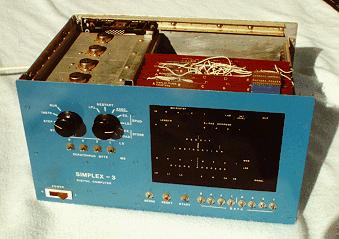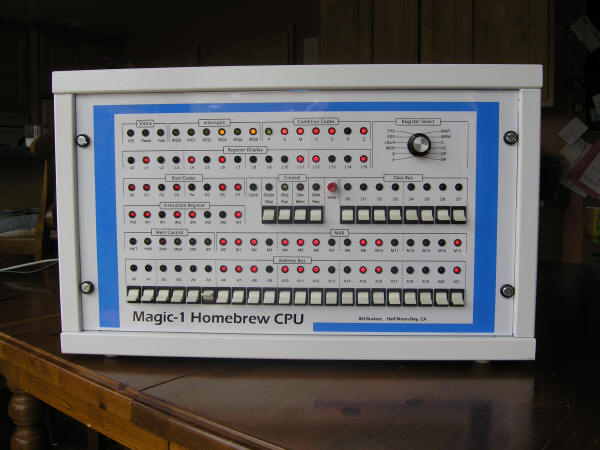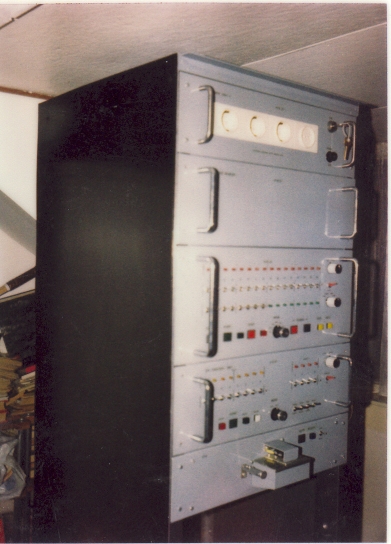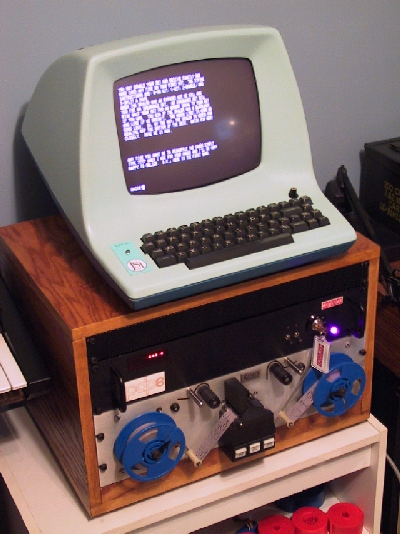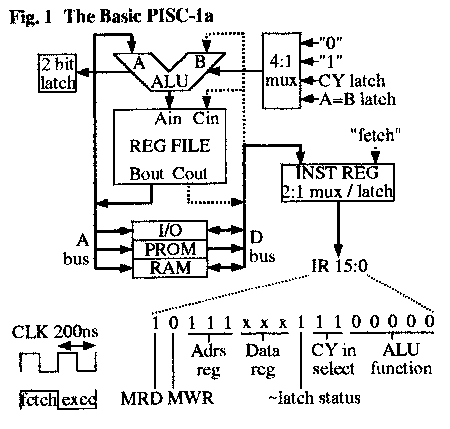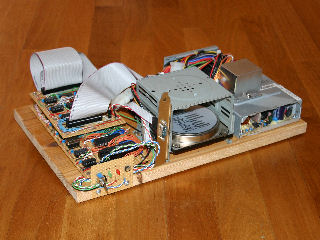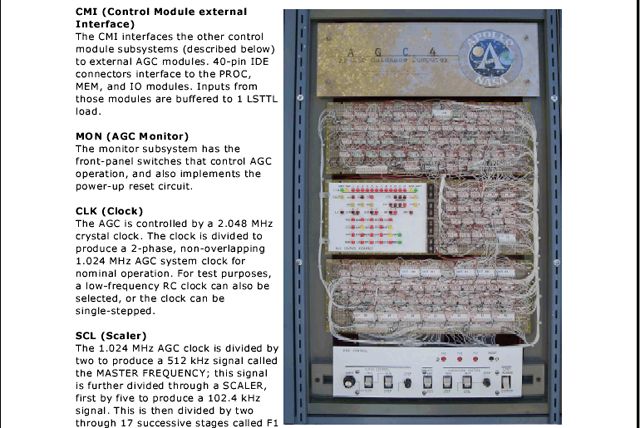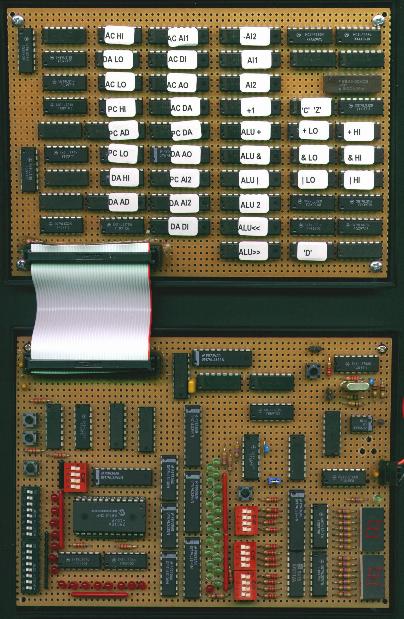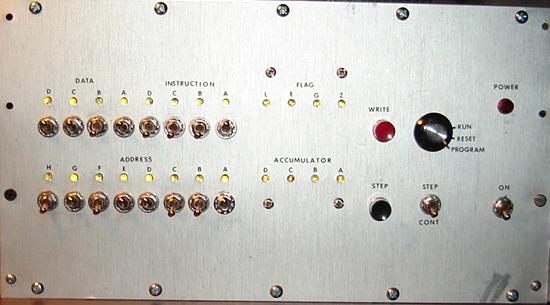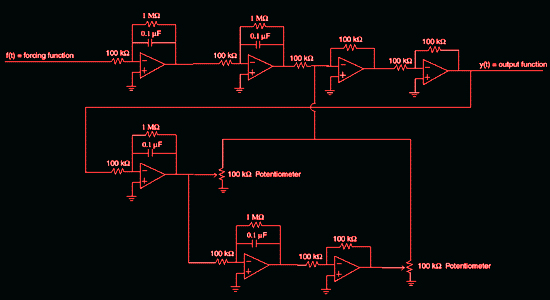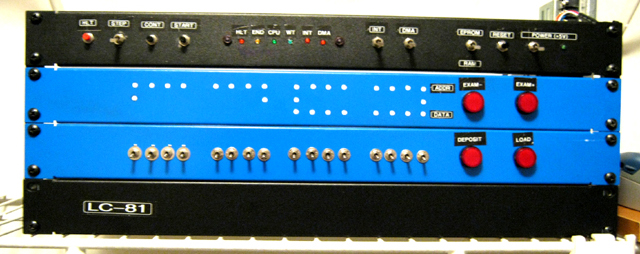Homebrew ComputersHarry Porter Relay Computer
http://www.cs.pdx.edu/~harry/Relay/index.html
This project triggered my interest for building a computer on my own. After a few days, however, I changed course toward electronics and OS development.
Nevertheless, the Harry Porter's Relay Computer is (in my view) a tremendous accomplishment and something really interesting to see.
Jon Stanley Relay Computer
http://www.electronixandmore.com/project/relaycomputertwo/index.html
This project is inspired in the Harry Porter's Relay Computer. The author adopts the idea and most of the solutions but he also introduces innovative changes and gives detailed information about his work.
David Brooks Simplex III (TTL)
The author, David Brooks, has also founded the "Homebuilt CPUs Web Ring".
http://members.iinet.net.au/~daveb/simplex/simplex.html
Bill Buzbee Magic-1 (TTL)
http://www.homebrewcpu.com/
Magic-1 is a homebrew minicomputer built by Bill Buzbee and made out of 74 Series TTL chips. It serves web pages to the internet and people can telnet to leave brief messages. Magic-1 runs the Minix 2 operating system which have been ported and optimized by Bill.
Bill devoted 4 years to the this project. Here is what he wrote about his tremendous effor on Software development:
-----
QUOTE
Although the hardware design and construction of Magic-1 usually gets the most attention, the largest part of the project (by far) has been developing/porting the software. To this end, I've had to write an assembler and linker from scratch, retarget a C compiler, write and port the standard C libraries, write a simplified operating system and then port a more sophisticated one. It's been a challenge, but a fun one. I suppose I'm somewhat twisted, but I happen to enjoy debugging difficult problems. And, when the bug you're trying to track down could involve one or more of: hardware design flaw, loose or broken wire, loose or bad TTL chip, assembler bug, linker bug, compiler bug, C runtime library bug, or finally a bug in the program in question there's lot of opportunity for fun. Oh, and I also don't have the luxury of blaming the bugs on anyone else.
I'm continually amazed that the damn thing runs at all, much less runs as well as it does.
-----
In this video (link below): a professional talk by Bill Buzbee about a Just-In-Time Compiler for Android systems he developed at Google.
http://code.google.com/events/io/2010/sessions/jit-compiler-androids-dalvik-vm.html
John Dorans D16/M minicomputer
The D16/M is a general-purpose, stored-program, single-address, 16-bit digital computer using two's complement arithmetic. It manages subroutine calls and interrupts using a memory stack. The processor may directly address 64K words of memory or I/O. Its timing and control unit is microprogrammed (fully horizontal, with a 72-bit control word).
http://www.timefracture.org/D16.html
Programming wizard Loren wrote a software emulator for the D16/M, and then used it to develop some applications--a keyboard monitor and a tough chess-playing program--even before I [John Doran] managed to get the hardware completed! Loren has placed all of his work on this site.
http://www.idcomm.com/personal/lorenblaney/d16.html
The 6502 Group
http://www.6502group.org/
--QUOTE FROM THE SITE--
The 6502 Group is one of the oldest computer clubs in the country. It has been meeting every Tuesday night since 1975.
"6502" is a bit of a misnomer these days. Originally a faction interested in the 6502 microprocessor split off from the Denver Amateur Computer Society (DACS). Since then the interests of the group have evolved to other processors -- notably the 80x86 and PICs -- but any technically oriented subject related to computers is discussed at meetings. Ironically one of the keys to the group's longevity is its lack of formal organization. There are no dues, no treasury report or minutes, no newsletter -- just folks discussing what interests them, showing off their latest creations, or seeking help on hard-core technical problems.
--END QUOTE--
The XPL0 Programming Language
http://www.idcomm.com/personal/lorenblaney/index.html
---QUOTE FROM THE SITE--
XPL0 is similar to Pascal and C. Although not mainstream, over the years it has proven to be immensely useful. It has been used to write everything from operating systems for 6502- and 68000-based computers, to commercial programs for 8088-based (PC) computers, to embedded firmware for PIC and other microcontrollers. Since its inception on the 6502, it has been steadily upgraded and spread to other processors such as 8080, 6800, PDP-10, IBM-360, a couple homebrew machines, 65802, 680x0, PIC, Ubicom, and, most notably, the 80x86 family used by IBM-compatible PCs.
---END QUOTE--
HJS22 contemporary MiniComputer
http://www.ibmsystem3.nl/hjs22/overview.html
This computer was built between 1975 and 1979, when commercial computers were built like that.
Donn Stewart 12/16 bits TTL CPU
http://cpuville.com/index.htm
This experimental TTL machine is both simple and elegant in design. It employes a FSM for producing the internal control signals where the states table is not stored in ROM but hard-wrired within the Control circuit.
Dawid DIY
http://www.pilawa.org/computer/
A DEC PDP-8 Clone
http://juliepalooza.8m.com/sl/pdp8e.htm
Homebrew Microcontroller based on FPGA
http://www.excamera.com/articles/20/mp3c.html
This homebrew CPU (or Microcontroller) is made on a FPGA (Field Programmable Gate Array). The memory organization is stack-based because the computer runs FORTH, a "stack oriented" language.
Some features:
Stack-based 16-bit CPU
No registers
1024 words of general purpose RAM
22 MIPS with a 66MHz basic clock
John FPGA Projects
http://members.optusnet.com.au/jekent/FPGA.htm
Papers by Bradford J. Rodriguez
http://www.bradrodriguez.com/papers/
Minimal TTL Processor
This work (by Bradford J. Rodriguez) is titled "A Minimal TTL Processor for Architecture Exploration". The machine is termed PISC. The paper covers very interesting details on CPU design matters. A list of found limitations is included, very useful for novices like my self.
http://www.bradrodriguez.com/papers/piscedu2.htm
Homebrew Z80 computer with HDD and OS
The computer:
http://www.cosam.org/projects/z80/
The OS (Focus):
http://www.cosam.org/projects/focus/index.html
How to replicate the Apollo Guidance Computer (AGC)
Quote from the site:
-------------------
Abstract
This report describes my successful project to build a working reproduction of the 1964 prototype for the Block I Apollo Guidance Computer. The AGC is the flight computer for the Apollo moon landings, with one unit in the command module and one in the LEM.
Why build an AGC?
Early computers are interesting. Because they're simple, you can (if you like) actually understand the entire computer, from hardware to software.
The AGC is the most interesting early computer because: it flew the first men to the moon and has interesting architectural features.
--- end Quote -----
http://klabs.org/history/build_agc/
Viktors Amazing 4-bit Processor
http://www.vttoth.com/vicproc.htm
Galactic Electronics 4-bits CPU
http://www.galacticelectronics.com/Simple4BitCPU.HTML
ELEC301 Project: Building an Analog Computer
http://www.owlnet.rice.edu/~elec301/Projects99/anlgcomp/
LC-81 Mini-Computer (based on Z80 microprocessor)
http://www.armandoacosta.com/lc81/
|




